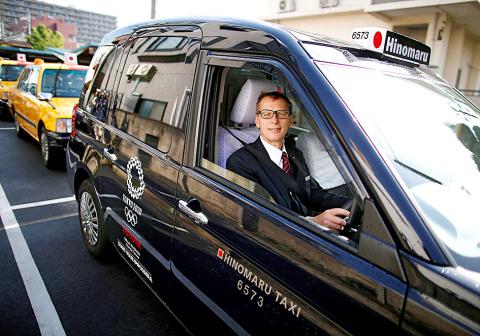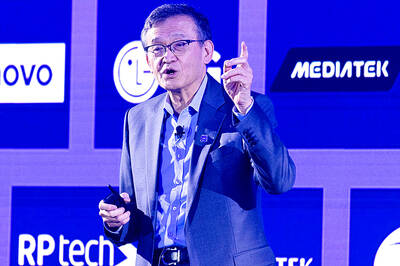Tokyo’s taxi industry is undergoing some radical changes as Japan, already dealing with unprecedented levels of tourism, gears up to host two major sporting events in the next 26 months.
More than 28 million tourists visited Japan last year and the government has set a goal of 40 million foreign visitors by 2020, loading more and more pressure on Tokyo’s already stressed transport system.
Toyota Motor Corp, the world’s largest automaker, believes it has at least part of the answer to this problem.

Photo: Reuters
Anyone who has hailed a cab in the Japanese capital is likely to have enjoyed a ride in one of the company’s iconic Comfort sedans, which make up more than 70 percent of Tokyo’s taxi fleet.
The car, which famously features an automatic opening door, has been in production for 22 years, but in October last year Toyota launched a new model, the JPN Taxi.
Adoption of the JPN Taxi, which has a liquid petroleum gas hybrid engine aimed at lowering carbon emissions, has been gradual, but Toyota said 10 percent of all of Tokyo’s taxi drivers have made the switch.
By the start of the Olympic Games in July 2020, the aim is for the new model to make up more than one-third of the fleet as Tokyo looks to make itself more accessible for those with disabilities, as well as the country’s aging population.
Japan has the world’s highest proportion of elderly people, with 27 percent of the population older than 65 and Toyota’s new car reflects this changing demographic.
“The very reason why we selected the universal design concept is because Japan is a ‘super-aging’ society, at a level we do not see in other countries in the world,” chief engineer Hiroshi Kayukawa told reporters at Toyota’s head office in Aichi Prefecture.
“We are seeing the cities becoming more and more barrier-free, but we also think public transportation should do more in this direction. That was the whole idea around this concept,” Kayukawa said.
The back seats of the JPN Taxi can be moved and a ramp, neatly tucked away under the seat, can be installed in seconds to accommodate customers in wheelchairs. There are also yellow markings and a light on the floor to aid the visually impaired.
“After the Olympics in Tokyo were decided, we looked into our concept and thought there would be a lot of convenience for tourists as well,” Kayukawa said. “There is also the potential that this taxi becomes an icon of Japan for foreigners visiting Japan.”
To that end, much thought was given to the choice of color for the exterior before Toyota selected Koiai, a deep indigo once derived from plant dyes.
“It is sometimes known as ‘Japan blue,’” said Kayukawa, who hopes the new model will become associated with Tokyo, much as the black taxi is with London and the yellow cab with New York. “It just so happens to be the color of the Olympic logo for Tokyo 2020, so we find that a happy coincidence and we hope that deep indigo becomes the image color of Japan.”
The makeup of the army of drivers who patrol the streets of Tokyo is also changing.
Hinomaru Kotsu Co Ltd, one of the largest taxi firms in the city, has recently hired 22 foreign drivers in time for next year’s Rugby World Cup and the 2020 Olympic Games.
With the average age of taxi drivers in Tokyo at almost 60 and a shortage of suitable drivers, Hinomaru started recruiting foreign drivers last year.
Austrian Wolfgang Loeger, who has lived in Japan for more than 30 years and until recently was a chef and ski instructor in the countryside, is one.
After moving to Tokyo last year and in need of a new job, Loeger found his calling behind the wheel.
“I saw the job advertisement, so I thought: ‘Let’s give it a try,’ because I like driving and I like to meet people,” Loeger told reporters as he navigated through the city. “You meet every time new people in the taxi, so I thought it was a nice job.”
Loeger, who is married to a local and speaks Japanese fluently, said he causes a stir when customers get into the taxi and see a foreigner in the driver’s seat.
“Of course, most of the time they say it is the first time they say they have had a foreign driver,” Loeger said, laughing. “It is a good way to start conversations, so usually they ask me where I am from, how long I have driven and these kinds of things.”
Hinomaru hopes that by having drivers like Loeger, who can speak a variety of languages, visitors will feel more at home in one of the developed world’s most homogenous societies.
With a fleet of spacious, modern cars, driven by characters such as Loeger, visitors to Japan for the Olympics can expect a comfortable ride on the streets of Tokyo in 2020.

The Eurovision Song Contest has seen a surge in punter interest at the bookmakers, becoming a major betting event, experts said ahead of last night’s giant glamfest in Basel. “Eurovision has quietly become one of the biggest betting events of the year,” said Tomi Huttunen, senior manager of the Online Computer Finland (OCS) betting and casino platform. Betting sites have long been used to gauge which way voters might be leaning ahead of the world’s biggest televised live music event. However, bookmakers highlight a huge increase in engagement in recent years — and this year in particular. “We’ve already passed 2023’s total activity and

Nvidia Corp CEO Jensen Huang (黃仁勳) today announced that his company has selected "Beitou Shilin" in Taipei for its new Taiwan office, called Nvidia Constellation, putting an end to months of speculation. Industry sources have said that the tech giant has been eyeing the Beitou Shilin Science Park as the site of its new overseas headquarters, and speculated that the new headquarters would be built on two plots of land designated as "T17" and "T18," which span 3.89 hectares in the park. "I think it's time for us to reveal one of the largest products we've ever built," Huang said near the

China yesterday announced anti-dumping duties as high as 74.9 percent on imports of polyoxymethylene (POM) copolymers, a type of engineering plastic, from Taiwan, the US, the EU and Japan. The Chinese Ministry of Commerce’s findings conclude a probe launched in May last year, shortly after the US sharply increased tariffs on Chinese electric vehicles, computer chips and other imports. POM copolymers can partially replace metals such as copper and zinc, and have various applications, including in auto parts, electronics and medical equipment, the Chinese ministry has said. In January, it said initial investigations had determined that dumping was taking place, and implemented preliminary

Intel Corp yesterday reinforced its determination to strengthen its partnerships with Taiwan’s ecosystem partners including original-electronic-manufacturing (OEM) companies such as Hon Hai Precision Industry Co (鴻海精密) and chipmaker United Microelectronics Corp (UMC, 聯電). “Tonight marks a new beginning. We renew our new partnership with Taiwan ecosystem,” Intel new chief executive officer Tan Lip-bu (陳立武) said at a dinner with representatives from the company’s local partners, celebrating the 40th anniversary of the US chip giant’s presence in Taiwan. Tan took the reins at Intel six weeks ago aiming to reform the chipmaker and revive its past glory. This is the first time Tan